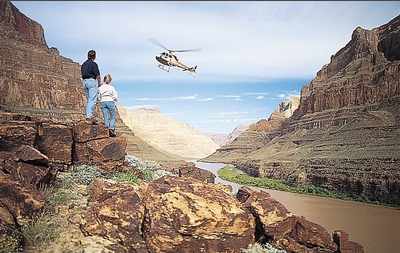Fri, Nov 09, 2007
Says FAA, TOPS Need To More-Closely Monitor Tours
 Spurred on by two
separate accidents involving helicopters conducting air tour
operations over the Grand Canyon, on Thursday the National
Transportation Safety Board issued recommendations to the Federal
Aviation Administration and the Tour Operators Program of Safety
geared towards weeding out problem pilots, before they can cause
accidents.
Spurred on by two
separate accidents involving helicopters conducting air tour
operations over the Grand Canyon, on Thursday the National
Transportation Safety Board issued recommendations to the Federal
Aviation Administration and the Tour Operators Program of Safety
geared towards weeding out problem pilots, before they can cause
accidents.
The Board cites the September 2003 downing of a Sundance
Helicopters AS350 A-Star in Descent Canyon, as well as an accident
two years before involving an AS350 flying for Papillon Airways, as
reasons for the recommendations. Over the course of its
investigations, the NTSB found the pilots involved in both
accidents had received complaints from passengers on previous
flights, stating they had flown recklessly.
Both pilots received complaints they had flown too closely to
canyon walls; in the case of the Papillon pilot, passengers
described incidents where the pilot would deliberately fly towards
a wall, with his head turned to talk with passengers in the back,
"until the passengers screamed for him to turn around" -- as well
as descending steeply "to show passengers what it was like to drive
a car off a cliff."
The NTSB also found those complaints were not addressed by the
respective companies.
Both Sundance and Papillon are enrolled in the Tour Operators
Program of Safety (TOPS). The companies receive independent safety
audits under the program, which also governs flight operations
within strict criteria.
The NTSB recommended the Federal Aviation Administration:
- Require periodic en route surveillance of all repetitively
flown commercial air tour routes in the Grand Canyon area,
including those routes located outside of the Special Federal
Aviation Regulations No. 50-2 airspace. (A-07-89)
- Require all commercial air tour operators to maintain records
of all safety-related complaints and complaint correspondence
regarding pilot performance, document what actions the company took
to address each complaint, and make the records available to the
principal operations inspector for periodic review. (A-07-90)
- Require all commercial air tour operators to maintain the names
and contact information of all passengers, along with the
respective flight's identification number, for at least 30 days
following the flights. (A-07-91)
- Encourage commercial air tour operators to establish a
structured flight operations monitoring program that incorporates
routine reviews of all available sources of information to ensure
that pilots are conducting flights in accordance with company
operating practices. (A-07-92)

In addition, the Board also recommended the Tour Operators
Program of Safety:
- Expand the safety audit program to include a review of records
of all safety-related complaints and complaint correspondence
regarding pilot performance. (A-07-93)
- Expand the safety audit program to include en route
surveillance of all repetitively flown commercial air tour routes
in the Grand Canyon area. (A-07-94)
- Revise the safety audit program guidance materials to include a
clear definition of "air tour flight" to ensure that auditors and
members effectively implement en route surveillance of all air tour
flight routes. (A-07-95)
FMI: Read The Full Recommendations Here And Here (.pdfs)
More News
Hold Procedure A predetermined maneuver which keeps aircraft within a specified airspace while awaiting further clearance from air traffic control. Also used during ground operatio>[...]
Altitude Readout An aircraft’s altitude, transmitted via the Mode C transponder feature, that is visually displayed in 100-foot increments on a radar scope having readout cap>[...]
Aero Linx: European Hang Gliding and Paragliding Union (EHPU) The general aim of the EHPU is to promote and protect hang gliding and paragliding in Europe. In order to achieve this>[...]
Also: Skydio Chief, Uncle Sam Sues, Dash 7 magniX, OR UAS Accelerator US Secretary of the Air Force Frank Kendall was given a turn around the patch in the 'X-62A Variable In-flight>[...]
"The need for innovation at speed and scale is greater than ever. The X-62A VISTA is a crucial platform in our efforts to develop, test and integrate AI, as well as to establish AI>[...]
 ANN's Daily Aero-Term (05.09.24): Hold Procedure
ANN's Daily Aero-Term (05.09.24): Hold Procedure ANN's Daily Aero-Term (05.06.24): Altitude Readout
ANN's Daily Aero-Term (05.06.24): Altitude Readout ANN's Daily Aero-Linx (05.06.24)
ANN's Daily Aero-Linx (05.06.24) Airborne-NextGen 05.07.24: AI-Piloted F-16, AgEagle, 1st 2 WorldView Sats
Airborne-NextGen 05.07.24: AI-Piloted F-16, AgEagle, 1st 2 WorldView Sats Aero-News: Quote of the Day (05.07.24)
Aero-News: Quote of the Day (05.07.24)




